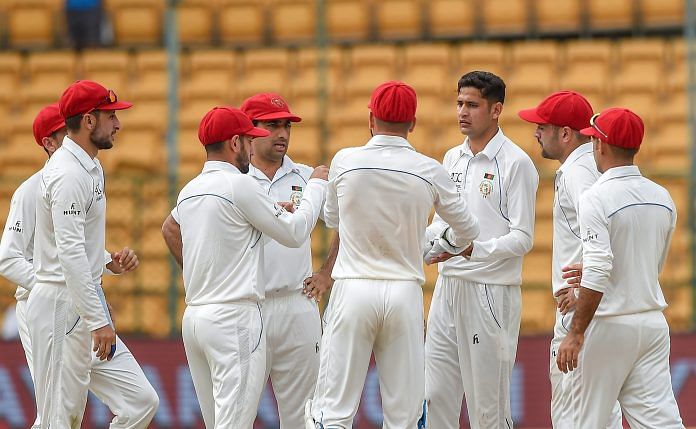From wielding a bat in a Peshawar camp and learning from YouTube, it’s been a long journey for Afghanistan’s cricketers who made their Test debut in Bengaluru.
Bengaluru: On 18 January 2010, a group of Taliban fighters, suicide bombers among them, launched a series of attacks in central Kabul even as Hamid Karzai was swearing in members of the cabinet at the presidential palace, one of the prime targets. Government buildings a shopping complex and a cinema were also hit in a siege-like situation that lasted hours and resulted in scores dead and hundreds injured.
Approximately 13,500 kilometres away, in sleepy Christchurch, New Zealand, Afghanistan’s future was playing an Under-19 cricket match against England, in the International Cricket Council World Cup. With the phone ringing off the hook from the newspaper office in Delhi, your correspondent approached the Afghan team’s manager in an attempt to speak to some of the players about the situation back home.
“I can’t let you do that,” he said, to bewilderment. “You might ask the players if one of their family members was affected, but what if a brother or father of one of our boys was involved in the attacks?”
In that exchange was a crisp summation of life in Afghanistan. Attacker or attacked? Perpetrator or victim? Sinned against or sinning?
On 14 June 2018, Afghanistan’s finest cricketers, resplendent in scarlet caps, took the field against India in their first Test match. The bombs continue to go off in Kabul, the attacks just as regular, only now, 30 dead warranted a brief mention in international newspapers. No outrage, no empathy, and not even an attempt to understand that life. Because, in 2018, Kabul was synonymous with violent chaos.
Except, here was a group of Afghans, in India, trying to put their country on the world map for something entirely different.
Yamin Ahmedzai, handed a shiny red SG ball, of the kind he may have never palmed before in his life, ran in to bowl the historic first ball, but realised something wasn’t quite right and pulled up in his delivery stride. Time did not stand still, but history was made to wait a moment.
The game got under way soon enough and while enthusiasm was not in short supply, expertise was at a premium. Two of Afghanistan’s bowlers were playing their maiden first class match, going up against players who spent every useful hour of their youth and adulthood on cricket grounds. Murali Vijay struggled initially, but persevered, as Test batsmen must, and Shikhar Dhawan feasted on the loose balls that came his way.
At lunch on the first day, India were 158 without loss. Yet, Afghanistan were the gainers in more ways than one. The No. 1 ranked Test team, playing at home, was expected to stomp out the format’s newest entrants. On most days, the scoreboard, like a balance sheet, is all you need to read. But this was an unusual day.
How could it not be for Mohammad Nabi, who learnt to bowl off spin and use a straight bat in Peshawar after his family fled the home country to escape the Soviet War? Nabi put the world on notice as far as Afghan talent, when he was the first player from his country to play in Twenty20 leagues around the world.
How could it not be for Rashid Khan, best known as the Sunrisers Hyderabad superstar spinner, who is no stranger to the confluence of cricket and violence. While he was wheeling away under the bright lights, a cricket game in his hometown, Jalalabad, was brought to a halt by three bombs, in which eight people died and more than 50 were injured. Rashid’s Afghanistan team-mate Karim Sadiq was ferrying the wounded to ambulances instead of taking his rightful place at the crease.
How could it not be for Mujeeb ur Rahman, Afghan born and bred, who did not learn the game in the refugee camps across the border, but went instead to YouTube to see how R Ashwin bowled the carrom ball, and spent hours on end attacking a single stump in solitude teaching himself the same craft?
How could it not be for Mohammad Shahzad, the wicketkeeper without the big gloves for this Test, standing at slip, arms akimbo like a heavyweight chef well past his prime? There is no Yo-Yo test that this man will take, nor one he can pass without the aid of a moped, but he is now a Test cricketer. He is the second man in the history of cricket to be able to play the Helicopter Shot, and the first is a giant of the game.
But before you tear up and get all sentimental, there is the small matter of India’s utter dominance of Afghanistan on a day when Bangalore unfurled her best weather. Cool morning breeze gave way to gusting winds, afternoon idyll transformed into the biblical rain and the non-contest of a cricket match, where India, at 264 for 1, were battering the bruised, was brought to a grinding halt.
In a world blighted by brutality, rain brought calm. The Tamil poet Thiruvalluvar, centuries ago proffered through a couplet that the world was preserved by rain and that this made the droplets from heaven akin to ambrosia. In Pashto, the language of the Afghans is another proverb that loosely translates to: That which thunders does not rain.
Afghan thunder was no match for Indian rain on their first day in Test cricket, but when their lightning struck, India felt it.
Four wickets fell for 54 runs when the weather cleared. The bankable Cheteshwar Pujara was tricked by a Mujeeb googly and the reliable Ajinkya Rahane became Rashid’s first Test wicket, trapped in front.
Rain is always reassuring, and usually brings relief, but nothing thrills quite as much as lightning, even if it only strikes randomly and rarely.



